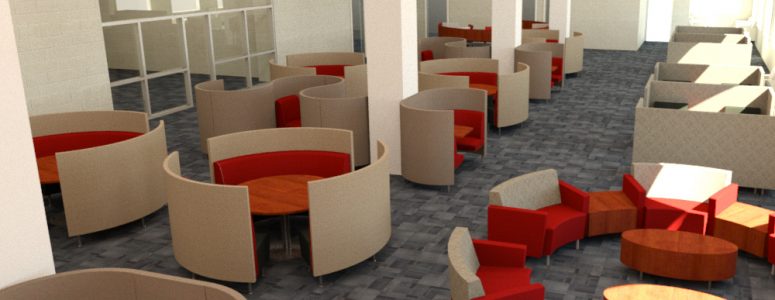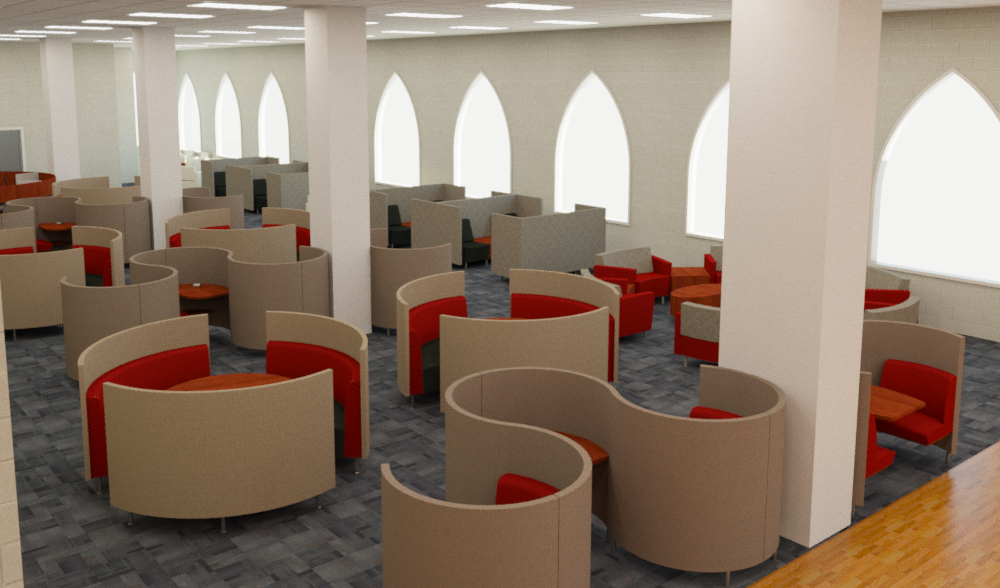
In our interview with Don Beagle, library director at Belmont Abbey College, we explore trends and insights in designing spaces for students.
The early stages of expanding or renovating your library are exciting. It’s an opportunity to go back to the drawing board and design a public space that truly meets the needs of your patrons and librarians.
But there’s a lot to consider. How do patrons use the space today? How will they use it in the future? How can you ensure every dollar is being spent wisely so your library will stand the test of time as technology and learning continues to evolve?

Don Beagle, library director at Belmont Abbey College, author and consultant.
Don Beagle has found himself answering these questions many times. He has decades of experience working in public and private libraries in North Carolina and South Carolina. Today Don is the library director of Belmont Abbey College where he directs all library operations. At Agati, we’ve worked with Don and his team on a just-completed $1.5 million renovation. We’re continuing our work together with an $8-10 million expansion for the Belmont Abbey College library.
We caught up with Don to learn about the changes he’s observed in libraries over the past 40 years, how he’s addressed the challenges of bridging print and digital and his predictions for what’s to come in the library spaces of the future.
This interview has been edited and condensed.
What are the most significant changes you’ve seen in library spaces over the last 10 years?
The first major shift started with the explosion of the Internet in 1995. It was a pivotal turning point in history that was just as significant as Gutenberg’s printing press. Suddenly, we were moving into the digital age at lightning speed.
This led a handful of university libraries to begin experimenting with a new model called the Information Commons (IC). In 1999, UNC-Charlotte hired me to start an Information Commons, only the sixth or seventh in the country at the time. Now there are probably between 350 and 400 across the U.S., with hundreds more in Canada, Europe and across the Pacific Rim. The second transformation was the Learning Commons (LC). Southern Cal hosted a national conference on the topic in 2004, and it’s only grown since then. Both IC and LC had have global impact in the world’s libraries.
I think one of the most important developments over the past ten years has been the completion and publication of assessments, evaluations and user studies of that first wave of IC’s and LC’s. Another important development of the past 10 years has been the explosive growth of technology: mobile devices, smartphones, e-readers and the spread of ubiquitous wi-fi.
What challenges have these shifts presented? How are libraries adapting?
For library managers, perhaps the most significant challenge presented by the now-proven success of the IC / LC model and the explosion of digital devices is this: What the heck to we do with our print collections?
Do we keep expanding and renovating our buildings (at great expense) to hold ever-growing print collections? Do we radically downsize those collections? Do we try off-site storage and / or collaborative multi-library arrangements? Libraries are trying variations of all these solutions.
All the while, knowledge growth has only accelerated. Digital has totally outstripped all feasible limits of print. We’re incredibly fortunate as a civilization that digital tech can feed our thirst for knowledge.
But now there’s another big challenge. We’re starting to understand how devices like e-readers, tablets and smartphones impact learning. Frankly, the results are very worrisome. Research shows students who read print books experience a significantly greater level of cognitive engagement than do readers of digital texts such as e-books.
This has serious implications for library managers. If you throw out or significantly weed down your print collection, you may also be throwing away your future students’ best opportunity to experience real learning. Right now, all signs still point to print book collections as the best portal to knowledge acquisition.
Of course, we may well see future enhancements to the e-reader experience. Digital paper innovations may yet lead to books that work like the magical newspapers in Harry Potter. Then we will need a new round of research studies to see whether the cognition, comprehension and retention gap between digital and print has been closed.
The tradition of print scholarship and bibliography are still vital. While I agree that the IC / LC model has been a nearly unqualified success, I disagree with those who seem to believe this requires wholesale elimination of print book collections.
Do you see a difference in how Gen X and Gen Z university students study, learn, gather and collaborate? How does that impact furniture choices and use?
To me, this fluidity and adaptability shown by Gen Z in the arena of hi-tech online interactions indicates that this generation has real potential to also fluidly adapt to hi-touch spaces for interpersonal collaboration and group process learning once they arrive on our campuses and enter the library LC’s of the future.
So how does that impact furniture choices? I’m confronting that question now as I move forward on planning and design for the prospective expansion of our LC at Belmont Abbey College. Whenever we create spaces where we expect increasing numbers of Gen Z students to gather with their ubiquitous hand-held and wearable technologies in tow, we must instantly expect increased ambient noise levels that potentially conflict with other nearby or adjacent library spaces where we still hope to preserve the “hushed temple of wisdom” paradigm from the Age of Print.
So my planning and design initiative centers on flex-space clusters of pods and banquettes. I’m seeking the best sound-dampening fabrics available. I still recall the ALA Summer Conference exhibit hall years ago where I first saw an Agati circular banquette on display. It had curved wood laminate surrounds that were visually strikingly beautiful, but my first thought was: “Wow, if we cloaked that curved surround in the best sound-dampening padded fabrics, then we’d have the LC group learning solution I’ve been searching for.”
Anyone who manages a learning space on a higher ed campus knows funding can be scarce. Do you have any helpful low-cost tips to create spaces that help students study, learn, gather and collaborate?
A few years before we got funding for our $1.5 million renovation at Belmont Abbey College, I needed to create a new small-class instructional space with 15 seats in one corner of our LC. So I went to a used office furniture dealer and picked up a fabric-covered office cubicle partitioning system like you might see in a stereotypical call center. With some reconfiguration using spare connector parts from the partition manufacturer, we created a workable group space for under $500.
What’s your approach for balancing individual (quiet) space with collaborative (noise) areas?
Let me continue my above story about the $500 office cubicle system we transmuted into a group instructional space. Because those partitions did not reach up to our ceiling, we soon had a problem with sound carry-over above the top edges into the adjacent areas of reading tables.
We were able to scrape together about $1,100 for a WhisperSpan acoustic soffit that fit between the top edge of the partition and the bottom of our suspended ceiling. So yes, the new acoustic treatment cost twice what the used partition had cost, but we still ended up with a workable sound-insulated group space for a total cost of $1,600.
What else can you share from your experience investigating acoustics and sound within library spaces?
I was part of the planning team for Charleston’s $14 million new main library in 1994-95. We were approached by distance learning staff with Clemson University. They wondered if some cooperative arrangement might be made to incorporate a group learning space for satellite downlinking. Sound pollution became a concern. By situating the satellite-downlink room “behind” dozens of ranges of print books, those ranges of books themselves became the ideal outer sound shielding we needed beyond the room’s stick-built partitions.
At Belmont Abbey College in 2009-10, we got a $100,000 LSTA Major Technology Grant to equip and implement the first iteration of our LC. Space and cabling constraints forced us into a strictly rectilinear layout because our network cabling had to be pulled down existing structural columns and nowhere else. This also required our rows of 50+ workstation carrels to physically touch those columns, then extend out within an ADA aisle-width of adjacent rectilinear reading tables.
So, how to create sound buffering between the workstation carrel-rows and the reading tables? We had already settled on modular Herman-Miller VIVO carrels, which were then on state contract pricing. With a bit of study, we learned we could purchase fabric-covered rear-side panels. For only $25 more per carrel, we could add acoustic padding to be inserted along the back-panels upon assembly. We gladly paid that extra $25 per carrel, and the results have been excellent.
That LC layout has worked for over nearly a decade now, with students using workstations at VIVO carrels within four feet of students reading books at tables. There have been almost no noise complaints.
If you had no constraints and could create any Learning Commons/Library space you wanted, what would it look like?
It would look very much like the LC expansion visual renderings that Agati’s Kelli Jo Dixon and I co-designed for our planned expansion project at Belmont Abbey College.

It’s basically a big rectangle with a large flex space across the middle for general collaboration. That central flex-space is populated by Agati pods (solo and duo) and banquettes (for small groups), all with circular or semi-circular form-factors and cloaked in fabric coverings. This creates a large open area where all clusters are separated by curvilinear aisles, in sharp contrast to the internal rectilinear arrays of our existing LC.
Within each pod and banquette, all directed sounds (from speech and devices) should reach central focal points within the pods and banquettes, so that only reverberated secondary sounds will extend beyond each circular surround. But because of the overall curvilinear plan, those peripheral reverberations will radiate outward in 360 degrees from each distributed source, causing swift volume reduction through those dispersal patterns.
I’m using normal interpersonal speech as the norm. If someone starts blaring Deep Purple “Smoke on the Water” at full volume, we’d still have plenty of sound disruption and annoyed students.
Now this entire central curvilinear flex-space will then be surrounded on three sides by perimeter tech-intensive labs, studios and study rooms partitioned off by DIRTT demountable partitions. The fourth side will be devoted entirely to windows for natural light. The whole big rectangle comes courtesy of the overall expansion designed by architect Bill Monroe of WGM Design in Charlotte, who also did our successful recent library renovation. And as I write this, Ryan Goeres and James Canales of Alfred Williams & Company in Charlotte are plugging Kelli Jo’s renderings into an ICE-software based platform to generate a large-screen interactive fly-through digital model of this entire LC design plan.
As collaborative learning has become more prevalent, what are the ingredients that create a truly effective environment?
I think the most effective collaborative environments emerge from the optimal mix of the following:
- Pedagogy
- Library service delivery
- Hybrid print and digital resource collections
- Fixtures, furnishings and equipment
With so much experience in these spaces/environments, any predictions for what the next library space transformation might be? Any new trends on your horizon?
I would vote for smart tech-intensive spaces that are coded to creatively interact with students’ handheld and wearable technologies. Brody Learning Commons at Johns Hopkins University is an early example of this with interactive display walls.
There’s already advanced smartwall technology from a company called T1V. Their ThinkHub software offers some of the most interesting potentialities I’ve seen. This video provides an excellent overview of the capabilities of T1V ThinkHub’s Interactive Collaboration Software.
What’s the most significant change you’ve made to a library that’s had the most impact?
For our $1.5 million renovation at Belmont Abbey College, I think the change I’ve made with the most long-range potential has been the purchase and installation of high-density shelving across our ground floor. This has increased our shelving capacity by 40% and allows us to continue the gradual growth of our print collection on the ground floor. Our technology-rich top-floor LC still offers students and faculty an ever-increasing array of collaborative spaces, databases, e-book collections and digital media resources.

More about academic library director, author and consultant Don Beagle
“I had always loved libraries with a passion,” Don says. “So the Library Studies and Information Science program seemed interesting in theory and practical in terms of employment prospects.”
After graduating from University of Michigan with his Masters of Library and Information Science in ‘77, Don spent the first 16 years of his career in public libraries. He managed a regional branch in Charleston, then became the head of Charleston’s main library. Don was part of the executive planning team for the design of Charleston’s new $14 million main branch.
Shortly after, Don joined the University of North Carolina at Charlotte as their associate library director and head of information commons — just as the library was kicking off a $17 million expansion. A few years later, Don became the library director of Belmont Abbey College, a role he still holds today directing all library operations. The library just completed a $1.5 million renovation project and planning is underway for an $8-10 million expansion.
Further Reading and Resources
- Conceptualizing an information commons by Don Beagle, The Journal of Academic Librarianship, Volume 25, Issue 2, March 1999, Pages 82-89
- The Information Commons Handbook by Don Beagle
- From Information Commons to Learning Commons: A White Paper for Presentation at the University of Southern California Leavey Library Conference by Don Beagle
- Against the Grain Interviews Donald Beagle by Purdue University Press
- From Learning Commons to Learning Outcomes: Assessing Collaborative Services and Spaces by Don Beagle
- The Reading Brain in the Digital Age: The Science of Paper versus Screens by Ferris Jabr, Scientific American
- The Emergent Information Commons: Philosophy, Models, and 21st Century Learning Paradigms by Don Beagle
